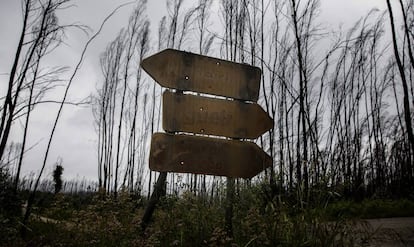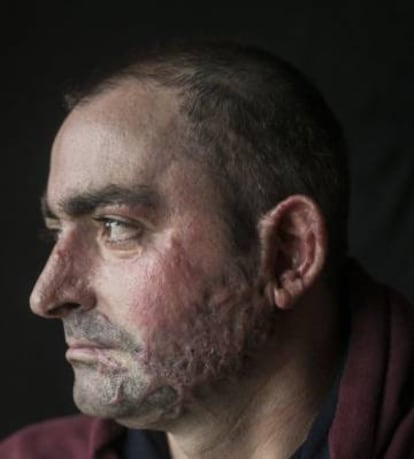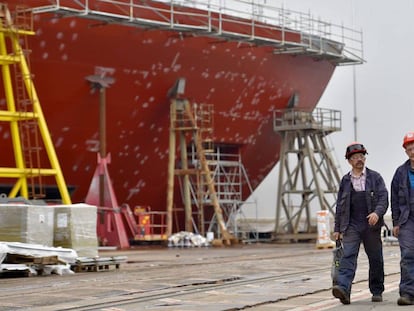Portugal’s devastating wildfires continue to burn
After last year’s fires, the European Union approved €50.6 million in financial aid to regenerate the affected areas. But 12 months on, neither the victims or the local authorities have seen a cent

The only sound heard in the 10,000 hectares scorched by last year’s fires in central Portugal is the roar of a chainsaw. Then, a few seconds later, the thud of a falling tree. Locals say last year’s summer was “hellish,” explaining that “everything that could have gone wrong, did.” Drought turned the fields into fuel for fire, strong winds turned flames into fireballs that devoured Eucalyptus trees like matches, and roads turned into death-traps where nearly 70 people died – “melted” according to firemen, by the 800°C temperatures. A year later, the area is paralyzed. Farmyards without chickens, fields without produce and traffic lights made illegible from scorch marks. Last winter, the European Union approved €50.6 million in financial aid from its Solidarity Fund to regenerate the area but 12 months on, neither the victims or the local authorities have seen a cent.
The European Parliament created the Solidarity Fund in 2002 specifically to help restore areas affected by natural disasters. The European Parliament – the institution financing this Citizens Europe series of articles – has unlocked this €50.6 million in aid (although the fires are estimated to have caused €1.485 billion in damages) but it has still not arrived. According to EU regulations, the process takes “several months.” The money must also be used within 18 consecutive months of being received, meaning the recovery effort could last years.
Of the €50 million approved, the government has promised to put €15 million toward improving forest conditions in the center of the country, says Miguel Freitas, the minister for forests and rural development, from his office in the Portuguese capital of Lisbon. “We are preparing for summer with an intensive campaign to clean up the forests,” he says.
What didn’t burn in 2017 will burn now because the countryside is unkempt and there are no resources Fire brigade volunteers
But forest engineer Paulo Freitas believes the issue is more complex: “A clean and orderly forest does not burn. The problem is management.” Forests cover 70% of Portugal and most of this is private property, making it difficult to manage, he explains. Many landowners have moved to cities or even abroad, letting the areas become overgrown. In the face of this fire risk, some local authorities clean up the forests and later charge the owners, who largely come from humble backgrounds.
“It’s a very unfortunate situation,” says Valdemar Alves, the mayor of Pedrógão Grande, the epicenter of last summer’s wildfires. In the area, there’s little activity save for the felling and clearing away of charred tree trunks. “Timber traders are the first to appear to clean up the field. They take what’s useful and leave what isn’t,” says Alves, who believes the wildfires “are a business.”
Asked about the EU funding, the mayor replies: “I never believed in it and I still don’t.” He says that Pedrógão Grande hasn’t received any money and even if it had, €50 million is a pitiful amount. “They may as well give us nothing.”
Bruno Pereira, regional secretary of European affairs, explains that because of EU bureaucracy funding delays, private companies and local and national authorities are putting up the money on the expectation that in one or two years they will be remunerated by the Solidarity Fund. Pereira says that it’s largely a question of trust. In the end, “everything depends on the speed at which municipalities act.”
Sitting in the living room of his apartment in Pedrógão, José Carlos Santos says he has received nothing “from either local or national authorities, or from the European Union.” The 38-year-old truck driver, who spent his youth transporting cereals between Zamora and Portugal, has burns to 35% of his body and visibly deep scars on his face, ears, head and hands. He wears compression bandages that cover his arms up to his shoulders, leaving only his nails visible. “They transplanted skin from my feet and my belly. Would you like to see?” he asks, lifting his shirt.

Santos remembers that night as if it were yesterday. He was in a truck fleeing from the fire down one of the narrow roads that snake through the hills of inner Portugal. He was with his brother-in-law Carlos and Vítor, a co-worker. Suddenly they found themselves surrounded by flames that spread rapidly, whipped up by the wind. They couldn’t see more than a meter ahead past the black smoke. A tire burst and the car toppled over. Vitor’s hands and face were covered in blood, remembers Sérgio Lourenço, the deputy commander at the local fire brigade who found and rescued them. Speaking from the same bend in the road where he brought them to safety, the fireman says Carlos was naked: “He only had his boots on,” and was forced to flee covering his genitals with his hands.
Although nearly suffocating, Lourenço was able to get inside the car. “I opened the door from inside, I couldn’t let myself get burned because I needed to help them. I wouldn’t be of use to anyone if I was burned,” he explains. Santos spent 52 days in the Coímbre hospital.
“My life has become very difficult. I never missed work for more than two days and now I’ve been off for more than a year,” he says. Santos sees a psychologist regularly, goes to the local clinic to have his skin treated and occupies himself the best he can. He drops off and picks up his nine-year-old daughter Leonor from school. He goes for coffee with friends. He visits his father-in-law. Now with the World Cup in Moscow, he’s in a better mood. The games keep his mind on other things, far from reality.
But with the World Cup comes summer, and with summer come the wildfires that scourge southern Europe, especially Portugal.
Forests cover 70% of Portugal but most of it is private property
Some 3,000 hectares of forest are at risk, says Fernanda David, the vice-president of the House of Pedrógão Association in Lisbon. “A lot of people think that what didn’t burn last time will burn this time around,” he warns. There is too little help and too much fear. “It was very hard. It’s going to take years for people to recover their mental health,” says the mayor of Pedrógão, who, at 69, has never seen such a big fire.
Indeed, nobody remembers a blaze of such magnitude. Mario and Maria Rosa, two farmers aged 75, describe from their stone cottage in Nodeirino how they spent “the whole night” with their bodies pressed up against a tank of water that now sits, partially scorched, on the top of a hill. “Only those who fled in their cars were killed. Those who stayed in their houses survived,” says Mario as he hauls grass for his sheep in a dilapidated wheelbarrow. By some miracle it doesn’t fall apart. “Those who stayed in the villages were the real heroes,” Alves agrees.
At the fire station, volunteers Ricardo and Michael play cards with other colleagues as they wait for another emergency. All is calm, but like their fellow countrymen they anticipate a difficult summer. “What didn’t burn in 2017 will burn now because the countryside is unkempt and there are no resources,” argue the volunteers. After the biggest fire in the country’s recent history, the only official help that the firefighters of Pedrógão have received is the 85% ownership of a fire truck that isn’t even equipped to carry water. Here it sits – uselessly – together with the other red vehicles waiting an emergency. And the summer has only just begun.
English version by John Clarke.
More information


